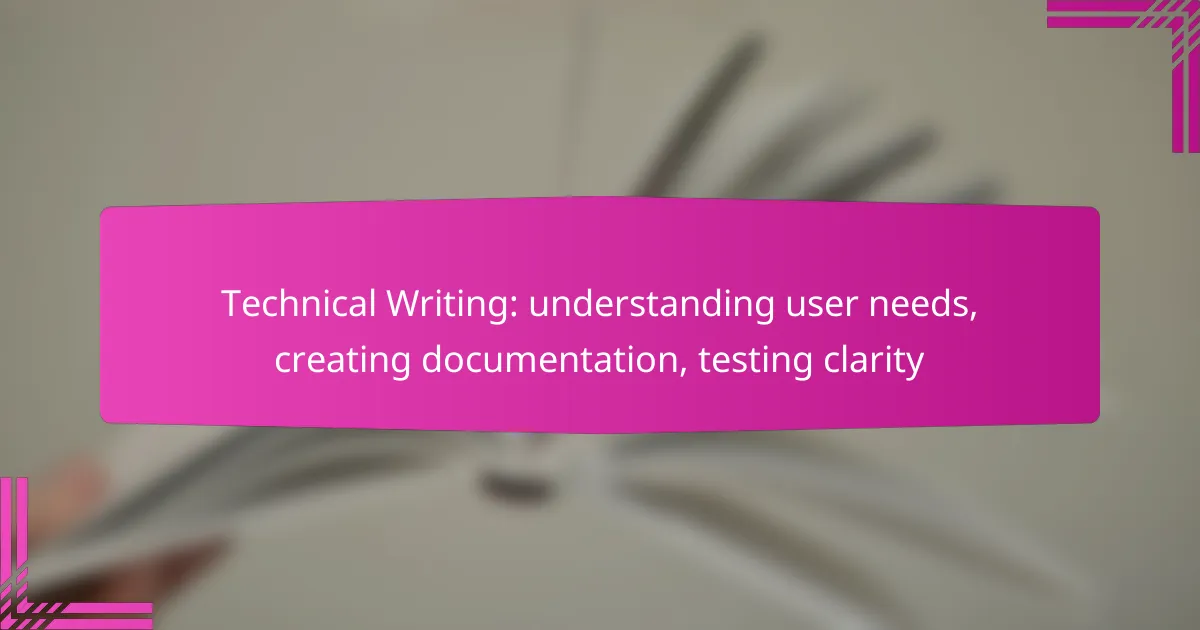Effective technical writing is essential for addressing user needs, particularly in Australia, where clarity, accessibility, and relevance are paramount. By understanding user preferences and organizing content thoughtfully, writers can create documentation that enhances usability and ensures users can easily find and comprehend the information they require. Testing clarity through user feedback and iterative improvements further ensures that the documentation meets its intended purpose.
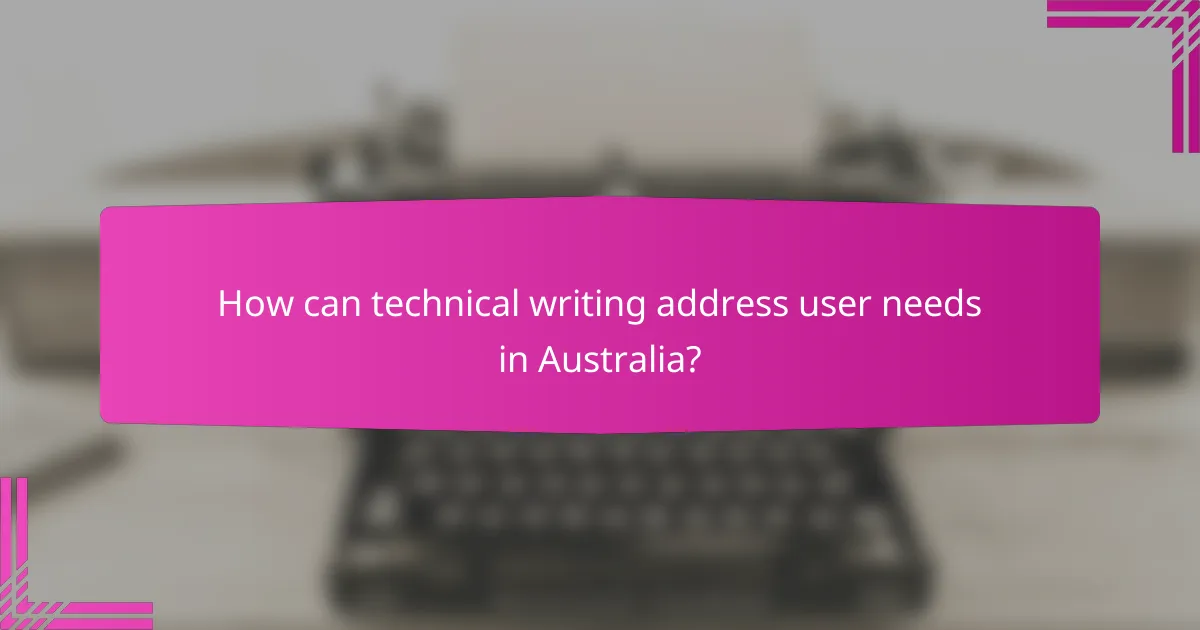
How can technical writing address user needs in Australia?
Technical writing in Australia can effectively address user needs by focusing on clarity, accessibility, and relevance. By understanding the specific requirements and preferences of Australian users, writers can create documentation that is both useful and easy to navigate.
User research techniques
User research techniques involve gathering insights directly from potential users to understand their needs and challenges. Common methods include surveys, interviews, and usability testing. In Australia, leveraging online platforms for surveys can yield quick feedback from diverse demographics.
Consider using tools like Google Forms or SurveyMonkey to create surveys that are easy to distribute and analyze. Aim for a sample size that reflects your target audience, typically ranging from 30 to 100 participants, to ensure meaningful results.
Understanding audience personas
Creating audience personas helps in tailoring technical documentation to meet specific user needs. A persona is a fictional representation of your ideal user, based on research and data. In Australia, consider factors such as industry, experience level, and regional differences when developing these personas.
For example, a persona for a software product might include a tech-savvy project manager in Sydney who values quick access to troubleshooting guides. This focus allows writers to address the unique preferences and pain points of different user groups effectively.
Gathering feedback effectively
Gathering feedback effectively is crucial for refining technical documents. Utilize methods such as beta testing, focus groups, and online feedback forms to collect user opinions. In Australia, consider setting up a feedback loop that allows users to easily report issues or suggest improvements.
Encourage constructive criticism by asking specific questions about clarity and usability. Aim to gather feedback from a diverse group, ensuring that you capture a wide range of perspectives. Regularly review and incorporate this feedback to enhance the quality of your documentation.
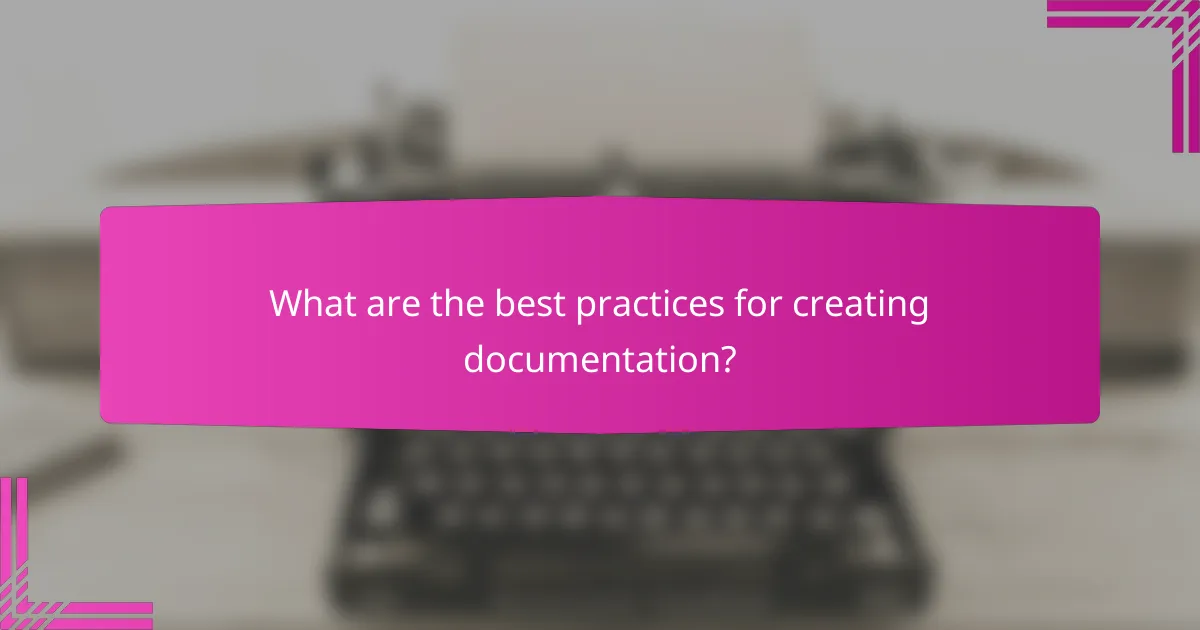
What are the best practices for creating documentation?
Best practices for creating documentation include understanding user needs, organizing content effectively, and ensuring clarity through consistent formatting. These practices enhance usability and ensure that users can easily find and comprehend the information they need.
Structured content development
Structured content development involves organizing information logically to facilitate user navigation and comprehension. Start by identifying key topics and subtopics, then create an outline that reflects the hierarchy of information. This approach helps users locate relevant sections quickly.
Consider using modular content blocks that can be reused across different documents. This not only saves time but also maintains consistency in terminology and style. Aim for clear headings and subheadings to guide users through the material.
Utilizing style guides
Utilizing style guides ensures uniformity in language, formatting, and presentation across all documentation. A well-defined style guide outlines rules for grammar, punctuation, and terminology, which helps maintain a professional tone. It can also specify preferred fonts, colors, and layout styles.
When creating a style guide, consider the audience and the context in which the documentation will be used. For example, technical documents may require more formal language, while user manuals can adopt a more conversational tone. Regularly review and update the style guide to reflect any changes in branding or user preferences.
Incorporating visuals and examples
Incorporating visuals and examples enhances understanding by providing context and illustrating complex concepts. Use diagrams, screenshots, and infographics to break up text and make information more digestible. Ensure that visuals are relevant and clearly labeled.
When providing examples, aim for clarity and relevance. Real-world scenarios help users relate to the material and see practical applications. Consider including a mix of simple and complex examples to cater to varying levels of user expertise.
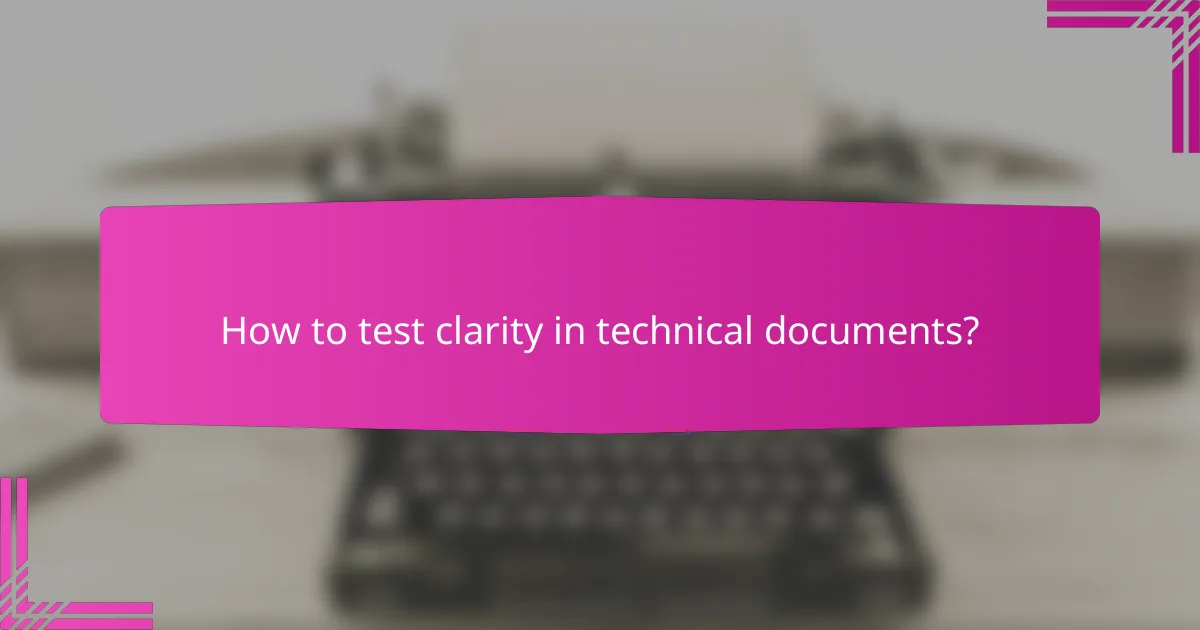
How to test clarity in technical documents?
Testing clarity in technical documents involves evaluating how easily users can understand the content. This process typically includes user testing methods, clarity metrics, and iterative feedback loops to ensure the documentation meets user needs effectively.
User testing methods
User testing methods are essential for assessing the clarity of technical documents. Common approaches include usability testing, where users interact with the document while observers note areas of confusion, and A/B testing, which compares two versions of a document to see which one users prefer.
Consider conducting focus groups to gather qualitative feedback on document clarity. This can help identify specific terms or sections that may be unclear to the target audience. Additionally, remote testing tools can facilitate broader participation, allowing feedback from users in different locations.
Clarity metrics and evaluation
Clarity metrics help quantify how understandable a document is. Common metrics include the Flesch-Kincaid readability score, which assesses text complexity, and the Gunning Fog Index, which estimates the years of formal education needed to understand the text.
Evaluating clarity can also involve tracking user comprehension through surveys or quizzes after document review. Aim for a balance between technical accuracy and user-friendly language to enhance clarity without sacrificing essential details.
Iterative feedback loops
Iterative feedback loops are crucial for refining technical documents based on user input. After initial testing, gather feedback, make necessary revisions, and then retest the updated document with users to ensure improvements have been effective.
Establish a regular schedule for feedback collection, such as after each major project phase or quarterly reviews. This continuous improvement process helps maintain clarity and relevance in documentation, adapting to evolving user needs and preferences.

What tools enhance technical writing in Australia?
In Australia, effective technical writing relies on a variety of tools that streamline documentation, facilitate collaboration, and manage content efficiently. Choosing the right tools can significantly improve clarity and user understanding.
Documentation software options
Documentation software is essential for creating clear and organized technical documents. Popular options in Australia include MadCap Flare, Adobe RoboHelp, and Microsoft Word. These tools often offer templates, version control, and export options to various formats like PDF and HTML.
When selecting documentation software, consider factors such as ease of use, integration capabilities, and support for collaborative editing. For instance, MadCap Flare is known for its robust features but may have a steeper learning curve compared to simpler tools like Microsoft Word.
Collaboration platforms
Collaboration platforms enhance teamwork and streamline the review process in technical writing. Tools like Google Workspace, Microsoft Teams, and Slack allow writers to share documents, gather feedback, and communicate in real-time. These platforms are particularly useful for remote teams across Australia.
When using collaboration tools, ensure that all team members are trained on the platform to avoid miscommunication. Establish clear guidelines for feedback to maintain document clarity and coherence throughout the writing process.
Content management systems
Content management systems (CMS) help organize and manage technical documentation efficiently. Popular CMS options in Australia include WordPress, Confluence, and Drupal. These systems allow for easy updates, version control, and user access management.
When choosing a CMS, consider the scalability and customization options available. A well-implemented CMS can save time and reduce errors in document management, making it easier to maintain up-to-date information for users.

How to choose the right technical writing tools?
Selecting the right technical writing tools involves assessing your specific documentation needs, team collaboration requirements, and the types of content you will produce. Consider factors such as ease of use, integration capabilities, and support for various formats to ensure efficiency and clarity in your documentation process.
Criteria for selection
When choosing technical writing tools, prioritize usability, collaboration features, and compatibility with existing systems. Look for tools that allow for easy editing and version control, as well as those that support multiple file formats like HTML, PDF, and Markdown.
Additionally, consider the learning curve associated with each tool. A user-friendly interface can significantly reduce onboarding time for new team members. Evaluate whether the tool offers templates or style guides to maintain consistency across documents.
Comparative analysis of popular tools
Popular technical writing tools include MadCap Flare, Adobe RoboHelp, and Confluence. MadCap Flare is known for its robust single-source publishing capabilities, making it ideal for large projects that require multiple outputs. Adobe RoboHelp offers strong multimedia support, which is useful for creating engaging content.
Confluence excels in team collaboration and integration with other Atlassian products, making it a great choice for teams already using Jira or Trello. When comparing these tools, consider factors such as pricing models, which can range from monthly subscriptions to one-time purchases, and the level of customer support provided.
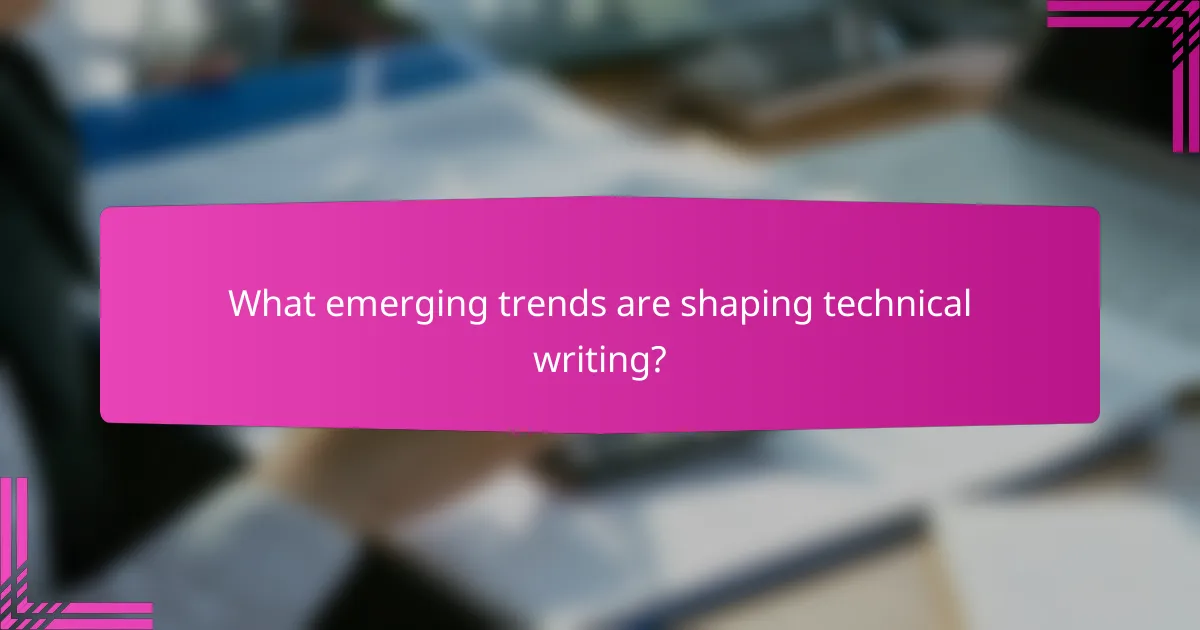
What emerging trends are shaping technical writing?
Emerging trends in technical writing focus on user-centered design, the integration of multimedia, and the use of artificial intelligence. These trends aim to enhance clarity, accessibility, and engagement in documentation.
User-centered design in technical writing
User-centered design prioritizes the needs and preferences of the end user in the creation of documentation. This approach involves gathering user feedback through surveys, interviews, and usability testing to ensure that content is relevant and easy to understand.
To implement user-centered design, writers should create personas representing different user types and tailor documentation to address their specific needs. Regularly updating content based on user feedback is also crucial for maintaining relevance.
Integration of multimedia elements
Incorporating multimedia elements such as videos, infographics, and interactive content can significantly enhance the effectiveness of technical documentation. These elements cater to different learning styles and can simplify complex information.
When integrating multimedia, ensure that it complements the text rather than overwhelming it. For example, a short video demonstrating a software feature can clarify instructions that might be confusing in written form alone.
Artificial intelligence in documentation
Artificial intelligence (AI) is increasingly being used to streamline the technical writing process. AI tools can assist in content generation, translation, and even user support, making documentation more efficient and accessible.
However, while AI can enhance productivity, it is essential to maintain human oversight to ensure accuracy and clarity. Writers should use AI as a tool to support their work rather than relying on it entirely, especially for nuanced topics that require human insight.
